
The soldier flies are a family of flies. The family contains over 2,700 species in over 380 extant genera worldwide. Larvae are found in a wide array of locations, mostly in wetlands, damp places in soil, sod, under bark, in animal excrement, and in decaying organic matter. Adults are found near larval habitats. They are diverse in size and shape, though they commonly are partly or wholly metallic green, or somewhat wasplike mimics, marked with black and yellow or green and sometimes metallic. They are often rather inactive flies which typically rest with their wings placed one above the other over the abdomen.
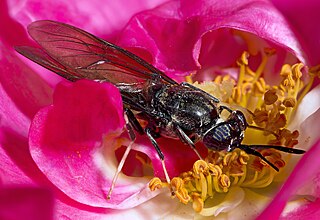
Hermetia illucens, the black soldier fly, is a common and widespread fly of the family Stratiomyidae. Since the late 20th century, H. illucens has increasingly been gaining attention because of its usefulness for recycling organic waste and generating animal feed.

Pantophthalmidae is a small family of very large, robust flies, sometimes referred to as timber flies. There are 21 known species in two genera in the family, all of Neotropical distribution. Superficially they resemble horse flies, but are only distantly related; they are most closely related to the soldier flies (Stratiomyidae). The larvae feed by boring into living wood, an unusual habit for Diptera, and can sometimes be pests. The adult stage is brief and does not feed at all, and most active at dusk.
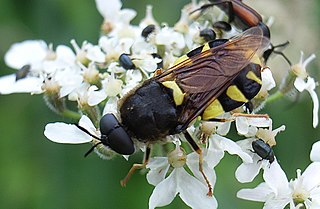
Stratiomyini is a tribe of flies in the family Stratiomyidae.

Oxycera is a genus of flies in the family Stratiomyidae.

Nemotelus is a genus of soldier flies in the family Stratiomyidae. Nemotelus is known from the Nearctic, Afrotropical and the Palaearctic regions.

Beris is a genus of flies in the family Stratiomyidae. They are also referred to as the false soldier fly. As described by Latreille in 1802, these are small to medium sized flies with metallic colors.

Actina is a genus of flies in the family Stratiomyidae.

Stratiomyinae is a subfamily of flies in the family Stratiomyidae.

Beridinae is a subfamily of soldier flies in the family Stratiomyidae.

Clitellariinae is a subfamily of flies in the family Stratiomyidae.

Pachygastrinae is a subfamily of flies in the family Stratiomyidae.
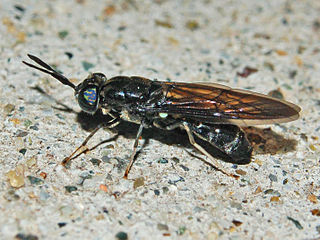
Hermetia is a genus of flies of the family Stratiomyidae.

Hermetiinae is a subfamily of flies in the family Stratiomyidae.
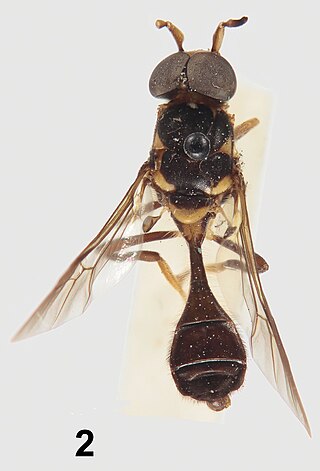
Parastratiosphecomyia stratiosphecomyioides is a species of fly in the family Stratiomyidae. It is native to Thailand. Its genus name comes from Ancient Greek, meaning "Near soldier wasp-fly", with its specific epithet meaning "wasp fly-like". It is considered to be the animal with the longest valid scientific name; the name Gammaracanthuskytodermogammarus loricatobaicalensis, an amphipod described in 1926 by Benedykt Dybowski, was longer, but was suppressed and is no longer valid, and the bacterium Myxococcus llanfairpwllgwyngyllgogerychwyrndrobwllllantysiliogogogochensis has the longest name of any organism, but it is not an animal. P. stratiosphecomyioides, sometimes referred to as the Southeast Asian soldier fly, was described in 1923 by British entomologist Enrico Brunetti. This insect is usually between 10.3 and 10.4 mm.

Prosopochrysini is a tribe of soldier flies in the family Stratiomyidae.

Allognosta is a genus of soldier flies in the family Stratiomyidae.
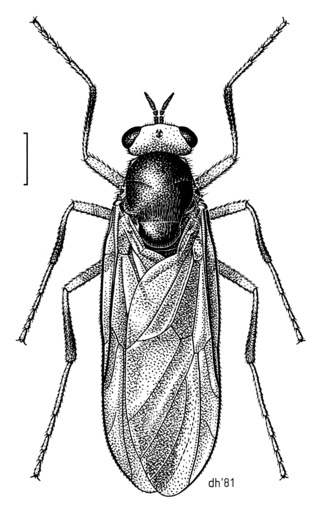
Inopus is a genus of soldier flies in the family Stratiomyidae.
Brachycara is a genus of flies in the family Stratiomyidae.
Brachyodina is a genus of flies in the family Stratiomyidae.















